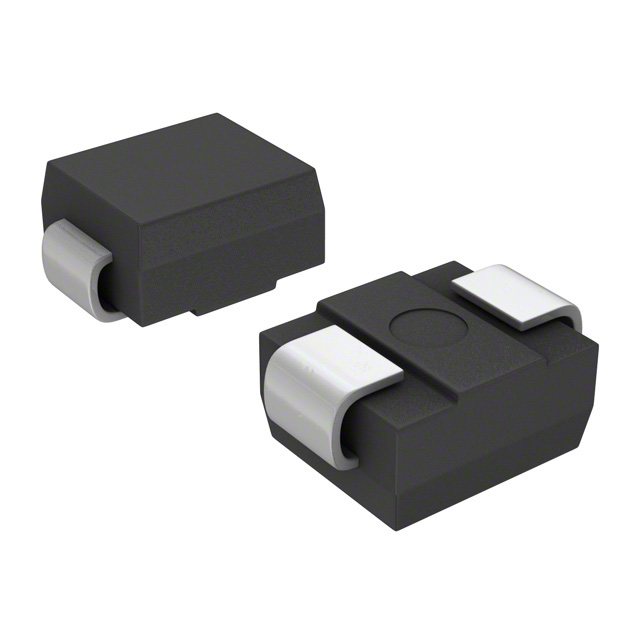P6SMB30AHE3/52 - Product Overview and Specifications
Introduction
The P6SMB30AHE3/52 is a transient voltage suppressor diode designed to protect sensitive electronic devices from voltage spikes and transients. This entry provides an in-depth overview of the product, including its category, use, characteristics, package, specifications, pin configuration, functional features, advantages, disadvantages, working principles, application field plans, and alternative models.
Product Category and Use
Category: Transient Voltage Suppressor Diode
Use: Protection against voltage spikes and transients in electronic circuits
Characteristics
- Voltage Rating: 30V
- Power Dissipation: 600W
- Package Type: DO-214AA (SMB)
- Essence: Provides robust protection for electronic circuits against transient voltage events
- Packaging/Quantity: Available in tape and reel packaging with varying quantities
Specifications
- Voltage Rating: 30V
- Peak Pulse Power: 600W
- Breakdown Voltage: 33.3V
- Clamping Voltage: 48.4V
- Operating Temperature Range: -55°C to 150°C
- Package Type: DO-214AA (SMB)
Detailed Pin Configuration
The P6SMB30AHE3/52 follows the standard pin configuration for SMB diodes: - Pin 1: Anode - Pin 2: Cathode
Functional Features
- Fast response time
- Low clamping voltage
- High surge capability
- RoHS compliant
Advantages and Disadvantages
Advantages: - Effective protection against transient voltage events - Fast response time ensures minimal impact on the protected circuit - RoHS compliance for environmental friendliness
Disadvantages: - Sensitive to excessive current or power surges - Requires proper heat dissipation in high-power applications
Working Principles
The P6SMB30AHE3/52 operates by diverting excess transient voltage away from the protected circuit, thereby limiting the voltage across the circuit during transient events. When a voltage spike occurs, the diode rapidly conducts, providing a low-impedance path for the transient current to flow through, thus protecting the downstream components.
Detailed Application Field Plans
The P6SMB30AHE3/52 is widely used in various electronic systems, including: - Telecommunication equipment - Industrial control systems - Automotive electronics - Consumer electronics - Power supplies
Detailed and Complete Alternative Models
- P6SMB6.8AHE3/52
- P6SMB10AHE3/52
- P6SMB15AHE3/52
- P6SMB24AHE3/52
In conclusion, the P6SMB30AHE3/52 transient voltage suppressor diode offers robust protection against transient voltage events and finds extensive use in diverse electronic applications.
Word Count: 410
Lista 10 Vanliga frågor och svar relaterade till tillämpningen av P6SMB30AHE3/52 i tekniska lösningar
What is the maximum peak pulse power dissipation of P6SMB30AHE3/52?
- The maximum peak pulse power dissipation of P6SMB30AHE3/52 is 600 watts for a 10/1000μs waveform.
What is the breakdown voltage of P6SMB30AHE3/52?
- The breakdown voltage of P6SMB30AHE3/52 is 26.7V to 29.5V.
What is the typical clamping voltage of P6SMB30AHE3/52?
- The typical clamping voltage of P6SMB30AHE3/52 is 48.4V at 42.8A.
What is the operating temperature range of P6SMB30AHE3/52?
- The operating temperature range of P6SMB30AHE3/52 is -55°C to +150°C.
What is the package type of P6SMB30AHE3/52?
- P6SMB30AHE3/52 comes in a DO-214AA (SMB) package.
What are the typical applications for P6SMB30AHE3/52?
- P6SMB30AHE3/52 is commonly used in surge protection for sensitive electronics, such as in telecommunications equipment, industrial control systems, and automotive electronics.
Does P6SMB30AHE3/52 meet any specific industry standards?
- Yes, P6SMB30AHE3/52 is compliant with RoHS and REACH standards.
What is the lead material of P6SMB30AHE3/52?
- The lead material of P6SMB30AHE3/52 is tin-plated, annealed copper.
Is P6SMB30AHE3/52 suitable for high-reliability applications?
- Yes, P6SMB30AHE3/52 is designed for high-reliability applications and has been qualified to AEC-Q101 standards for automotive applications.
Can P6SMB30AHE3/52 be used in outdoor environments?
- Yes, P6SMB30AHE3/52 is suitable for outdoor use and is designed to withstand harsh environmental conditions.


